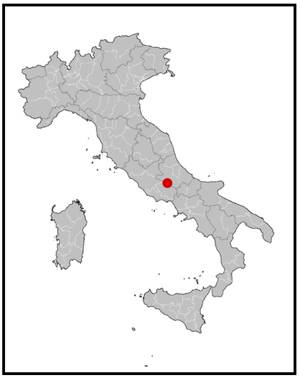Homo cepranensis
Online Biology Dictionary
|
|
EUGENE M. MCCARTHY, PHD
Homo cepranensis is the name Mallegni et al. (2003) gave to a supposedly new type of hominid. It was based on a single skullcap (pictured below) dating to 800,000–900,000 BP.

|
|
Italo Biddittu
|
It was unearthed in a road construction project near Ceprano, Italy in 1994 (Manzi et al. 2001). The fact that the material was of human origin was recognized by Italo Biddittu of Rome's Institute of Paleontology, who happened to be present when the remains came to light.
Most paleoanthropologists now think, however, that the skullcap in question should actually be assigned to Homo erectus.
Homo cepranensis: What's in a name?

|
|
Location of Ceprano |
There is a tendency among paleoanthropologists, and among biologists in general, to assign species names to specimens that might just as well be assigned to existing taxonomic names. Something about erecting a new name makes even a rather humdrum specimen take on a glow that would otherwise be absent. With a new name one tends to assume that something profoundly different and new has been discovered. It's like a distribution company renaming and re-releasing an old movie. Many people are tricked and go to see it again. The same thing works for fossils. Call an old dog fossil a "canithere" or a "kyphomorph" and you teach it new tricks. It becomes (at least for those who haven't studied their Greek and Latin roots) somewhat more interesting. Call it a dog, and it may send an otherwise willing audience to the Land of Nod. The same is true of the fossils of humans and human relatives. Who's going to get excited about yet another specimen of Homo erectus? Haven't we had more than enough of those? That's why a new hominid specimen named, say, Homo rosa might not, by any other, previously used name, smell as sweet!
 Holotype of Homo cepranenis. Numbers represent the following morphological features: Features 1 to 4 (black) traits that are more exclusive of Mid-Pleistocene specimens (i.e. 1: incomplete sulcus supraorbitalis, 2: frontal tuber weakly developed medially shifted, 3: supraorbital region medially concave, 4: intermediate position of the external auditory meatus in regard to the processus zygomaticus temporalis); 5 and 6 (blue) = more derived traits (i.e. 5: straight torus occipitalis transversus, 6: medio-lateral concavity of the articular tubercle); 7 to 10 (green) = more primitive traits (i.e. 7: petro-tympanic crest orientated downward, 8: opisthocranion coincident with inion, 9: processus retromastoideus, 10: torus angularis parietalis). Image: Wikimedia
Holotype of Homo cepranenis. Numbers represent the following morphological features: Features 1 to 4 (black) traits that are more exclusive of Mid-Pleistocene specimens (i.e. 1: incomplete sulcus supraorbitalis, 2: frontal tuber weakly developed medially shifted, 3: supraorbital region medially concave, 4: intermediate position of the external auditory meatus in regard to the processus zygomaticus temporalis); 5 and 6 (blue) = more derived traits (i.e. 5: straight torus occipitalis transversus, 6: medio-lateral concavity of the articular tubercle); 7 to 10 (green) = more primitive traits (i.e. 7: petro-tympanic crest orientated downward, 8: opisthocranion coincident with inion, 9: processus retromastoideus, 10: torus angularis parietalis). Image: Wikimedia
Most shared on Macroevolution.net:
Human Origins: Are we hybrids?
On the Origins of New Forms of Life
Mammalian Hybrids
Cat-rabbit Hybrids: Fact or fiction?
Famous Biologists
Dog-cow Hybrids
Georges Cuvier: A Biography
Prothero: A Rebuttal
Branches of Biology
Dog-fox Hybrids